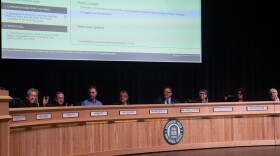RENEE MONTAGNE, host:
This is MORNING EDITION from NPR News. I'm Renee Montagne. There are hundreds of dead zones in the world's coastal oceans. Dead zones are bottom waters that don't have enough oxygen to support marine life.
In the latest issue of the journal Science, researchers have identified 405 dead zones, and they say that these polluted waters are now the leading threat to life in coastal oceans. NPR's John Nielsen has more.
JOHN NIELSEN: Taken together, the 405 dead zones cover 95,000 square miles, an area the size of New Zealand. The biggest dead zone found in U.S. waters appears every summer in the Gulf of Mexico. The biggest one in the world is in the Baltic Sea in northern Europe, and it lasts almost all year round.
The newest global count is the work of Robert Diaz, a marine biologist at the Virginia Institute of Marine Science. He says most of the dead zones are found near crowded coastlines in the northern hemisphere.
Mr. ROBERT DIAZ (Virginia Institute of Marine Science): So you have Europe heavily populated with dead zones, North America heavily populated. Japan is virtually covered with them, and now we're seeing reports coming out of China, India and even the Middle East, where the dead zones seem to be a problem there too.
NIELSEN: Diaz says dead zones are usually found near the mouth of rivers polluted by fertilizers. Nutrients in these fertilizers feed big algae blooms that die and sink to the ocean bottom. The bacteria that feeds on this dead algae takes most of the oxygen out of the water.
The first scientific reports of dead zones appeared in 1910, says Diaz. There were only four that year.
Mr. DIAZ: If you go into the literature prior to the '60s, 1960s, you don't find very many accounts of systems with low oxygen, and even in some systems today that are - have really big problems with oxygen, in the '40s, '50s and '60s, these are the areas where model communities were described for the invertebrate fauna, and now they have oxygen problems.
NIELSEN: Diaz says his research seems to show that the number of dead zones in the world's oceans has been doubling every 10 years since the 1960s, but he also says it hasn't been easy to draw attention to the problems posed by these dead zones.
Several years ago, when scientists located what's now known as the world's largest dead zone in the Baltic Sea, Diaz says local fishermen paid no attention to the warnings of hypoxic or oxygen-free waters. They also ignored predictions that the sea life living in these waters would soon begin to flee or die.
Mr. DIAZ: In one year the fishermen reported record catches of Norway lobsters, and they just laughed at the scientists, saying, oh, there's no problem here.
Well, what they didn't know, the fishermen, that is, they were catching hypoxia-stressed animals, and that was it. They caught them that year, and after that the fisheries collapsed in this area, and it has still not recovered.
Jane Lubchenco, a marine biologist and dead zone expert at Oregon State University, hopes this survey will get people's attention.
Ms. JANE LUBCHENCO (Oregon State University): It really says that dead zones are increasing exponentially around the world, that it's likely they're going to increase in the future, but also that we can go in a different direction, that the problem could be addressed.
NIELSEN: Lubchenco and others say dead zones can be fixed and in some cases have been fixed. For example, runoff rules have helped keep fertilizers out of New York's Hudson River, she says. That in turn has helped shrink the dead zones found near the mouth of the Hudson River.
Ms. LUBCHENCO: Over a billion people a day depend on seafood for their sole or primary source of protein. Dead zones are increasingly threatening these very productive waters, and it behooves us to do everything we can to make sure that those areas are as healthy and productive as possible, and in this case that means reducing the flow of nutrients to them.
NIELSEN: But Diaz says he worries that dead zones may soon start spreading beyond the northern hemisphere. That's because agriculture development in the southern hemisphere could mean those countries will start using more fertilizers in the years to come.
Mr. DIAZ: The real problem there is South America. It has a climate and a land mass with a similar fertility to North America, and if agriculture and population expand there, I suspect we'll see a lot of dead zones being reported, even along the coast of Chile with the development of aquaculture. There are a number of new accounts that didn't even get into our study that are there now.
NIELSEN: Diaz says the spread of these dead zones is happening so fast that it outstrips all of the other problems facing the world's oceans. John Nielsen, NPR News, Washington. Transcript provided by NPR, Copyright NPR.






